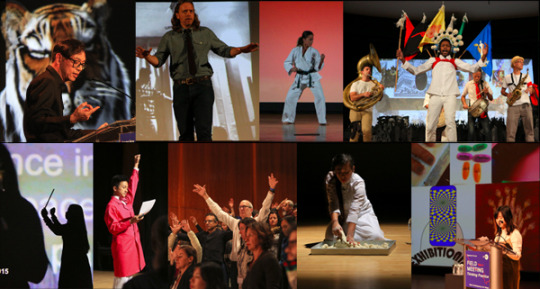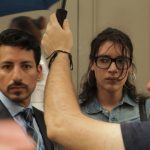Interview: Leeza Ahmady, Director of Asia Contemporary Art Week, ACAW
“My personal mission as ACAW’s director is to create visibility for significant artistic content that is generally unrepresented, otherwise inaccessible, or that needs specific or broader contextualization.”
Born and raised in Afghanistan, Leeza Ahmady is a New York-based independent curator and the director of Asia Contemporary Art Week, ACAW, a dynamic platform that brings together leading New York and Asian-based art institutions, museums and galleries to present the largest showcase of cutting-edge exhibitions, innovative projects, and provocative dialogues on current topics.
NYFA: Can you give us an overview of ACAW?
LEEZA AHMADY: In 2001, a small group of curators, museum directors, and gallery owners came together to create the Asia Contemporary Art Consortium (ACAC) to address their disenchantment with the still very euro-centric New York art scene at that time. They decided to initiate Asia Contemporary Art Week (ACAW) under the fiscal sponsorship of Asia Society, with a mission to collaborate and achieve critical attention for contemporary art from Asia in the United States.
ACAW has since grown as a curatorial and educational platform with a 200,000+ audience reach each year and over 2000 artists presented. I have directed 8 editions of the platform, expanding and broadening its programming in partnership with renowned US and Asia-based institutions, museums, and galleries to create cutting edge exhibitions, innovative projects, provocative dialogues on current topics, and networking opportunities. This fall, in its 12th edition (October 10 – 26, 2017), we will present an extensive overview of the current artistic endeavors in Asia through our signature program, Thinking Projects. Thus alongside presenting our now critically acclaimed annual signature art forum for arts professionals, FIELD MEETING, in October, we are also launching a citywide pop-up exhibition that will introduce artists working in and out of Asia to New York.
My personal mission as ACAW’s director is to create visibility for significant artistic content that is generally unrepresented, otherwise inaccessible, or that needs specific or broader contextualization; as well as to spotlight the work of ACAW’s Consortium partners and participating organizations as important contributors to the field.
NYFA: You have many long term partnerships and short term collaborations. What makes these relationships so successful? How do you expand your relationships with individual artists and organizations in New York?
LA: My work with ACAW involves the vigorous exercise of scoping, identifying, framing, and channeling artistic activity on distinct levels of collaboration. It is kind of an exhausting and invigorating marathon that I love to run. One of the skills I’ve managed to develop is to keep the insight that the art world has many parts and that each part plays an important role at the forefront of my mind. I see it as an ecology, a landscape. Because of this perspective, I’ve been able to include and engage with all spectrums of the art scene: the nonprofit and for-profit museums and galleries, academic institutions, art biennials and festivals, smaller arts organizations with similar missions, community organizations, and artistic collectives as well as auction houses and art fairs. I have achieved this by being conscious of each entity’s mission and by creating and envisioning programs that appeal and address the needs of all these varying operating sectors while keeping the empowerment and promotion of artists at the very top of ACAW’s priority. Please see the diverse list of our current ACAW Consortium Partners here.
It’s all about making practical, conceptual use of what resources are already there and sharing the spotlight without being invasive of any one’s territory. For example, a smaller organization like Japan Society has a very particular focus and audience. Connecting with ACAW means that they open their program to a larger audience interested in Asia. For The Met, a museum that already has a wide-ranging, mainstream audience, they might need the specificity of Asian connoisseurs. Identifying ways to collaborate in realistic scales that tap into already existing budgets and resources or making more effective use of them is also important. So collaborations do not necessarily have to happen in the form of major exhibitions but through significant smaller projects, performance, screening or artists residencies, etc. We try to propose meaningful projects that expand and complement the roster of what’s already being offered by our partners while simultaneously highlighting their respective efforts.

One has also to respond to the ebbs and flows within the scene so we can have greater access to what’s going on inside the regions with those who are involved firsthand. We have also been organizing off-site programs with our partners in Asia to facilitate between institutions, curators, and artists while FIELD MEETING and other ACAW signature programs are launchpads for them in the United States. These activities have attracted more participants and have allowed us to take ACAW to the next level in the last few years.
In 2014, I also introduced FIELD MEETING as the signature program of Asia Contemporary Art Week with the intention of questioning what I call an East-West superiority-inferiority complex, where individual artists are often represented through a particular place, artistic style or a mass movement. The program, which unfolds as a two day art forum with over 30 presenters in each take, is modeled after a studio visit on a large communal scale centered around the presentation of performances, lecture-performances, and artists talks. For professionals in the field, the studio visit means engaging with the artist’s own presence and voice, giving insight into his or her process and intent — a kind of a one-on-one connection that becomes a catalyst for deeper long-term relationships. By bringing together an exclusive audience of arts professionals (curators, museum and gallery directors, collectors and critics) to attend FIELD MEETING to connect directly with artists and their presence, we facilitate an exchange that is far beyond established institutional representation and discourse with much greater nuance.
NYFA: How do you choose artists to be on the program and do you have any advice for artists looking for opportunities?
LA: One important aim for ACAW is to support the process of how Asia concentrates and connects with itself. With FIELD MEETING, I am interested in more than just curating the artists’ finished artworks. I’m interested in what artists are thinking about and researching. I am interested in a new model for exhibition-making, one that showcases process rather than objects; the presentation of artists and creative urgencies in a less mediated fashion that also broadly reconsiders Asia as a complex and conceptual space beyond geography, while also addressing the large gaps in the ratio of Asia-based artists represented in the United States.
What makes ACAW and its signature programs compelling is the independent research that lends an independent perspective with a collaborative and inclusive approach. In selecting artists, I connect with various colleagues, consortium partners, and other networks of professionals in the field to nominate artists and outstanding practitioners. Beyond artists, we also invite curators and leaders of organizations and museums to present in our programs. For FIELD MEETING we require that all participants propose and develop original, provocative performance-lectures, performances, or to present in other formats that captivate the most essential aspects of their practices overall. We share elaborate and clear criteria and are very hands on with the development and production of what is presented in each iteration. FIELD MEETING Take 5: Thinking Projects this year further considers artists as active agents in civic life by highlighting their artwork stemming from long-term projects. Capturing the heightened urgency to take art outside of the white box and into open spaces and communities, artists and practitioners directly question institutional boundaries and traditional modes of infrastructure.
As for advice for artists, I say make work because you are feeding your practice; have it become as essential as breathing. Do not make work dependent on an exhibition, invitation to a biennale, or a sale. It’s just really about the practice you’re constantly developing, the way a piano player constantly practices their piano skills. These days many artists have the results-oriented rather than the healthy process-oriented approach. Success will come. It’s important to have discipline regardless of who is looking or not looking at your work. That’s what I’m looking for when I’m selecting artists for programs and exhibitions. I choose based on what, how, or why they’re doing what they are doing and its impact on them and others. I would also advise that you try to travel as much as possible, not just through art residencies but on your own, go to other places, test out your ideas, make work, interact with other kinds of communities. There is a kind of magic in that. You may tap into interest in your work that you don’t find in your ordinary surroundings.

NYFA: Can you tell us about your experience being part of NYFA Fiscal Sponsorship?
LA: ACAW was initiated and operated under the fiscal sponsorship of Asia Society, but it has always operated and raised funds independently with a focused intention to represent a body of arts organizations in a strong collective voice. Our relationship with NYFA further highlights and reflects this independence. NYFA’s support of diverse organizations and artistic projects is also appealing, and we hope that we can begin to really connect with NYFA’s expansive network. This interview is a great opportunity to tell an important story about a significant and evolving sector of the contemporary art world and therefore the current unfolding narrative of one of the largest continents with the largest population on the planet and countless languages, cultures, religions, and artistic heritages.
Learn more about Leeza Ahmady and ACAW.
This interview is part of the ConEdison Immigrant Artist Program Newsletter #92. Subscribe to this free monthly e-mail for artist’s features, opportunities, and events here.
– Interview conducted by Alicia Ehni, Editor of the IAP Newsletter and Program Associate, NYFA Learning
Images from top to bottom: Leeza Ahmady at the opening of her exhibition with Arahmaiani at Tyler Rollins Fine Art, 2014, courtesy of Asia Contemporary Art Week (ACAW) and AhmadyArts; FIELD MEETING Take 4: Thinking Practice, Signature Art Forum of Asia Contemporary Art Week (2016), Hosted by the Solomon R. Guggenheim Museum and Asia Society Museum; and Lee Mingwei: Sonic Blossom performance-exhibition, co-presented as the signature exhibition ofAsia Contemporary Art Week (2015) at the Metropolitan Museum of Art.






